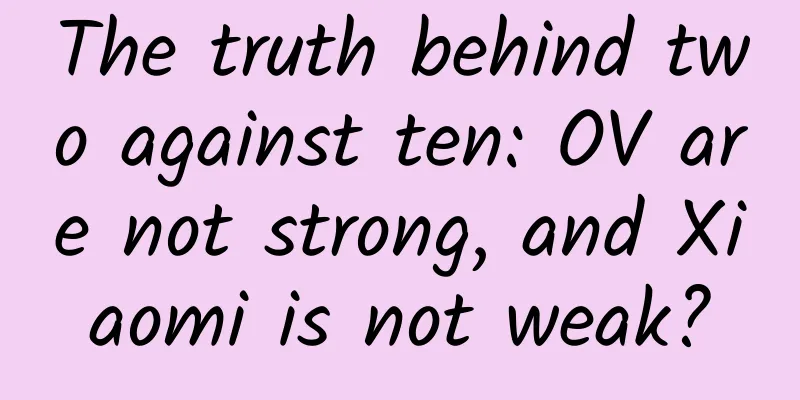The truth behind two against ten: OV are not strong, and Xiaomi is not weak?

|
Recently, two anthropomorphic pictures circulated online by netizens once again showed the fierce competition in China's smartphone market. Xiaomi once again became the target of public criticism. One of the pictures showed the so-called two against ten, that is, 10 Chinese mobile phone brands including Huawei, Honor, OPPO, and vivo were competing against Xiaomi and its spin-off Redmi. Another picture showed Huawei and Honor standing aside (quite like watching the fight from a mountain), while OPPO's realme, which returned to the Chinese market, fought with Redmi, and OPPO and vivo besieged Xiaomi. I wonder what the industry thinks after seeing these two almost entertaining photoshopped pictures? What we find strange is that although Xiaomi is still growing in the global smartphone market, it is in a downward trend in the Chinese market and is even being criticized. Then why is it the "public enemy" of Chinese mobile phone manufacturers in the eyes of the industry? Especially since this year, OV (the second photoshopped picture), which is in the second camp with Xiaomi, has been accused of directly targeting Xiaomi and Redmi, whether it is the establishment of a new brand or the return of realme. In fact, the industry knows that although it seems that a number of Chinese mobile phone manufacturers are challenging Xiaomi in the photoshopped picture, judging from the current market reality, since Huawei (including Honor) is already far ahead of its peers in the Chinese market, Xiaomi has basically posed no substantial threat to it. As early as last year, Honor had already declared that Xiaomi was no match for it. As for other Chinese mobile phone manufacturers, apart from OV, the other Chinese mobile phone manufacturers that are supposed to challenge Xiaomi are nothing more than a bunch of "sea-climbing" and it is difficult for Xiaomi to make any serious damage, especially with its cost-effectiveness. Then the only one left is OV. From the performance and changes of OV in the Chinese market from last year to this year, Xiaomi is indeed OV's biggest rival now and in the future to some extent. Last year, it played the "innovation" card madly, but failed to challenge Huawei, and its growth rate was lower than Xiaomi As we all know, last year OV changed its high-profile entertainment marketing and began to focus on the so-called "innovation" card, and promoted it in the media. The reason why OV adopted this strategy is that the growth of China's smartphone market began to slow down, and manufacturers hoped to increase the price of mobile phones to make up for the sluggish shipments. Secondly, Huawei, which has always focused on innovation, not only gained sales, but also gained brand premium and influence, which made Chinese mobile phone manufacturers admire it. Among all Chinese mobile phone manufacturers, OV has a certain sales base due to its previous success in entertainment marketing and the accumulation of channels. It is considered (including OV itself) to be the manufacturer that is ready to challenge Huawei's strength in the high-end market with innovation. Last year, OPPO's Find X and vivo's NEX were considered to be representatives of OV's high-end mobile phones built with innovation, and they achieved good sales. However, judging from the performance of the entire Chinese market last year, the truth is far from what we see. Previously, market research institutions IDC, Counterpoint, Canalys, and Canalys all released reports on the Chinese smartphone market last year. According to the IDC report, OPPO's shipments fell by 2% year-on-year, while vivo's shipments grew by 11% year-on-year; according to the Counterpoint report, OPPO's shipments fell by 8% year-on-year, while vivo's shipments fell by 2% year-on-year; according to the Canalys report, OPPO's shipments fell by 2% year-on-year, while vivo's shipments grew by 9% year-on-year; according to the Canalys report, OPPO's shipments fell by 6% year-on-year, while vivo's shipments grew by 3% year-on-year. Here, we see that the various statistical agencies once again have differences in their estimates of the increase or decrease in OV shipments. For the sake of fairness, we selected IDC's report as the standard. First of all, for OPPO, the statistics of the four statistical agencies all showed a year-on-year decline, ranging from 2% to 8%, and the decline in IDC's statistics was the smallest. As for vivo, three of the four statistical agencies showed year-on-year growth, ranging from 3% to 11%, and the other one showed a year-on-year decline, with a decline of 2%, while IDC's statistics showed the largest growth, at 11%. Next, let's look at revenue. Since we use the shipment statistics from the statistical agency that is most favorable to OV, we also use IDC's statistics for revenue statistics to ensure objectivity as much as possible. Also according to IDC's statistics, from the perspective of revenue, OPPO's revenue last year fell 11% year-on-year, and vivo's revenue fell 2% year-on-year. Combining the above-mentioned OPPO's shipment decline of 2% year-on-year and vivo's year-on-year growth of 11%, we can see that OV's revenue has not shown a positive growth relationship with shipments. For example, the decline in OPPO's revenue has far exceeded the decline in shipments. Even Vivo, whose shipments increased by 11% year-on-year, saw its revenue decrease by 2%, which is in sharp contrast to the OV strategy of driving growth in the high-end market through innovation. Therefore, we have come to the conclusion that OV’s so-called innovation last year failed to achieve the expected results, either in terms of the essence of innovation or publicity, and was even far from it. To support our point of view, we introduce the statistical changes in the shipment volume share of each price range of major manufacturers in the Chinese smartphone market to illustrate this. According to statistics from Aurora Big Data, in the first quarter of last year, in the price range of 3,000 yuan (including 3,000-4,000 yuan and above 4,000 yuan) and above (Aurora Big Data defines models priced above 3,000 yuan as high-end phones), OPPO accounted for 10.1% of its own shipments and vivo accounted for 16.7%; in the first quarter of this year, in the same price range, OPPO accounted for 10.1% of its own shipments and vivo accounted for 18.6%. That is to say, after a year of playing the innovation card, OPPO's high-end phone shipment ratio has not increased at all, and vivo has only increased slightly by 1.9%. In contrast, Huawei's share of its own shipments in the above-mentioned high-end price segment soared from 13.5% in the first quarter of last year to 28.4% in the first quarter of this year, an increase of 1.1 times. It can be seen that although both focus on innovation, OV and Huawei are far from being on the same level in terms of confidence in innovation and market recognition. This also tells us that innovation is not a marketing slogan, but real accumulation, investment and research and development. In fact, let alone challenging Huawei, after a year, in the high-end market, OV's growth rate is not even as fast as Xiaomi's. According to the statistics of Jiguang Big Data, in the first quarter of last year, Xiaomi's shipments in the price range of more than 3,000 yuan accounted for zero, while in the first quarter of this year, Xiaomi's shipments in this price range accounted for 8%, although it is still lower than OV's 10.1% and 18.6%, but the growth from zero to 8% should make OV, which focuses on innovation, ashamed. It should be noted that Xiaomi's current shipment ratio in the price range of more than 3,000 yuan is only less than 2% of OPPO. If OV hopes to challenge Huawei in the high-end market with a premium in the name of innovation, but the gap is getting bigger and bigger, and it is no longer on the same level as Huawei in the high-end market, then Xiaomi is the most direct competitor to OV in the future to seize the price segment above 3,000 yuan. So the question is, if we look at the high-end market, although OV's growth rate is slow, the shipment ratio has basically not decreased. For example, OPPO is flat year-on-year, while vivo has increased by 2%. So why is OV's overall revenue declining? Especially vivo, whose shipments increased by 11% year-on-year, but revenue declined by 2%? The transformation from low-end to mid-end is slow, and the competitiveness of the core mid-end market is weakened Industry insiders familiar with OV know that the mid-range market has always been the core competitive market for OV. Although the mid-range market is still the main force in China's overall smartphone market (the same is true for mainstream manufacturers), OV is the best in terms of competitiveness. Therefore, the decline in both sales and revenue of OPPO, and the decline in revenue of vivo despite a significant increase in sales, must be due to the core competitiveness of the mid-range market. Here we still quote the statistics of Jiguang Big Data. First, let's look at the low-end market of 0-999 yuan. In the first quarter of 2018, OV accounted for 6.1% and 18% of their overall shipments in this price range, respectively. In the first quarter of this year, the proportions were 1.7% and 13.8%, respectively. The proportion of low-end phones in their own mobile phone shipments decreased by 72% and 23.3%, respectively. In contrast, Xiaomi, which has always been regarded as low-end in the industry, has seen its shipment ratio of low-end phones in the 0-999 yuan price range drop from 54.6% in the first quarter of last year to 32.4% in the first quarter of this year, a decrease of about 40%. This decrease exceeds that of vivo, although not as much as OPPO. However, given that low-end phones previously accounted for more than half of Xiaomi's overall shipments, while OPPO only accounted for 6.1% and vivo for 18%, it is clear that Xiaomi's ability to break away from low-end phones is much better than that of OV. The 22.2% shipment ratio of Xiaomi that has broken away from low-end phones has obviously entered the core mid-end market of OV. Of course, in addition to Xiaomi, Huawei's brand influence established through innovation has rapidly made it move away from the low-end. Its shipment ratio of low-end phones priced between RMB 0 and RMB 999 has dropped sharply from 38.5% in the first quarter of last year to 8.9% in the first quarter of this year, a decrease of 76.9%. Considering the previous proportion of low-end phones, Huawei's ability to move away from low-end phones is far greater than that of OV, and this part of the reduced shipments has flowed to the core mid-end market of OV and its own high-end market. To prove the decline of OV's competitiveness in the core mid-range market, let's take a look at the changes in the shipment ratio in the mid-range market. Although Jiguang Big Data defines 1,000-3,000 yuan as mid-range phones, it still divides this range into 1,000-1,999 yuan and 2,000-2,999 yuan price ranges. In the 1,000-1,999 yuan price range, OPPO's shipment ratio increased from 41.4% in the first quarter of last year to 55% in the first quarter of this year, and vivo increased from 52% to 54.1%; in the 2,000-2,999 yuan price range, OPPO's shipment ratio decreased from 42.4% in the first quarter of last year to 33.2% in the first quarter of this year, while vivo increased from 13.3% to 13.5%, basically the same. From this point of view, in the mid-range market core of OV, OPPO has lowered a price dimension to participate in the competition (the price segment of 2,000 yuan to 2,999 yuan has dropped by as much as 21.7%, and the price segment of 1,000 yuan to 1,999 yuan has increased by 32.8%), while vivo has barely maintained the shipment ratio in the high-priced segment of the mid-range market, but the shipment ratio in the price segment of 1,000 yuan to 1,999 yuan has also increased by 4%. In comparison, Xiaomi's shipment proportion in the 1,000-1,999 yuan price segment increased from 31.9% in the first quarter of last year to 38.3% in the first quarter of this year; the 2,000-2,999 yuan price segment increased from 13.6% to 21.3%, with year-on-year growth of 20% and 56.7% respectively. At the same time, Huawei's shipment proportion in the 1,000-1,999 yuan price segment also soared from 21% in the first quarter of last year to 39.7% in the first quarter of this year, a year-on-year increase of 89%. Although the proportion in the 2,000-2,999 yuan price segment dropped from 27% to 23%, given that Huawei's shipment proportion in the high-end market above 3,000 yuan increased by 1.1 times, we can conclude that the decline in Huawei's shipment proportion in the 2,000-2,999 yuan price segment should be fully transferred to the higher-end market (comprehensively suppressing the growth of OV high-end phones). It was precisely Xiaomi's 56.7% growth in the price range of 2,000 yuan to 2,999 yuan that forced OV to drop one price segment in the mid-range market, that is, to compete in the low-price segment of the mid-range market of 1,000 yuan to 1,999 yuan, in order to alleviate the pressure of declining sales. Even so, in the past year, OPPO has not been able to curb the double decline in shipments and revenue. Although vivo has maintained sales growth (after all, it still has 13.8% low-end shipments), it has seen a large increase in sales but the embarrassment of declining revenue. More importantly, judging from the trend last year, Huawei will inevitably continue to increase its shipments in the high-end market in the future, and thus completely block OV's high-end road. As for OV's core mid-range market, as of the first quarter of this year, Xiaomi still had 32.4% of its shipments in low-end phones. According to the conversion rate of Xiaomi's low-end to mid-range shipments last year, it is bound to put further pressure on OV in the mid-range market. This also explains why OPPO will move the realme brand in the Indian market to the domestic market this year under the name of realme X (priced between 1,000 yuan and 2,000 yuan). It is nothing more than to maintain its competitive strength in the price range of 1,000-1,999 yuan and try its best to curb the decline in shipments. As for vivo, although it seems to be better than OPPO on the surface, in fact, judging from the fact that its shipments increased by 11% year-on-year last year, but its revenue decreased by 2% year-on-year, its hidden dangers may be more serious than OPPO. At this point, some people may question that we are only talking about the decline of OV, but isn’t Xiaomi’s performance in the Chinese smartphone market also declining? And the decline is even greater than that of OV. Well! Here we list the statistics of Xiaomi's performance in the Chinese market for the whole of last year and the first quarter of this year. Since we used IDC's statistics on shipments and revenue of China's smartphone market last year, which is the most favorable for OV shipment statistics, we still use this statistics for Xiaomi in order to ensure objectivity. The statistics show that Xiaomi's smartphone shipments in China fell 6% year-on-year last year, which was larger than OPPO's 2% year-on-year decline and smaller than vivo's 11% year-on-year growth. However, Xiaomi's revenue increased by 14% year-on-year, while OPPO's revenue fell by 11% and vivo's revenue fell by 2%. I believe the industry has its own judgment on this result and trend. Through the above analysis, we believe that since Xiaomi’s previous label of cost-effectiveness (actually a low-priced phone below 1,000 yuan) is deeply rooted in the market, it is normal to lose sales in the process of upgrading. However, OV is different. In the past year, OV has basically been maintaining its competitiveness in the core mid-range market by reducing its dimension, in order to ensure that its sales do not decrease. In the first quarter of this year, according to the Canalys report, OPPO's smartphone market in China fell 4% year-on-year, vivo fell 2% year-on-year, and Xiaomi fell 13% year-on-year; according to Counterpoint's statistics, OPPP's smartphone market in China grew 7% year-on-year, vivo grew 7% year-on-year, and Xiaomi fell 21% year-on-year. Such a big gap in statistics has appeared again. Who is right and who is wrong, others can't tell, but manufacturers should have a clear mind, so let the industry make their own judgments! However, as a listed company, Xiaomi recently released its first quarterly financial report of this year. In the financial report, Xiaomi said that according to statistics from a third-party agency, Xiaomi's mobile phone market share in China has continued to grow for three consecutive months in the past three months, and its mobile phone ASP (average selling price) has increased by 29.9% year-on-year. Regarding Xiaomi's financial report mentioning that its market share in the Chinese smartphone market has increased for three consecutive months, we would like to add some statistics from Counterpoint, which showed that when it calculated China's smartphone shipments in the first quarter of this year, it gave a quarter-on-quarter increase or decrease in shipments. Xiaomi grew 3% quarter-on-quarter, while OPPO fell 8% quarter-on-quarter and vivo fell 6% quarter-on-quarter. As for the growth of ASP, combined with the detailed price segment analysis we used previously, we can confirm that Xiaomi is indeed rapidly switching from low-end phones to mid-end phones with OV as the core, and it is inevitable that OV will face further impact from Xiaomi in the mid-end market in the future. What is more worth mentioning is that compared with OV, Xiaomi's development strategy in the smartphone market has greater redundancy, which is probably the biggest shortcoming and hidden danger of OV. The mobile phone business is overly dependent on the domestic market, and single business is a major hidden danger It would be a big mistake for the industry (including OV) to measure itself and its competitors, especially Xiaomi, which is closely following it, simply based on the growth or decline of the Chinese smartphone market. First of all, from the perspective of pure smartphone business, OV currently has and only has the single smartphone business to generate revenue and profit, and both sales, revenue and profit are too dependent on the Chinese market. In contrast, Xiaomi's mobile phone business is much more balanced. Xiaomi's just-released Q1 financial report this year cited Canalys' statistics, saying that Xiaomi's smartphone shipments ranked among the top five in more than 40 countries and regions in the first quarter of 2019. In addition, Xiaomi's smartphone shipments in the Western European market increased by 115.1% year-on-year in the first quarter of 2019, ranking fourth in market share in terms of smartphone shipments. Seeing this, it is easy to understand why we have focused on analyzing the specific performance of OV and Xiaomi in the Chinese smartphone market, and even the reasons for the competition in price segments. Because for OV, the smartphone business, especially the Chinese smartphone business, cannot afford any mistakes, which is also the main reason why we believe that even if Xiaomi loses 1,000 yuan and hurts OV 800 yuan, the loss to OV will be much greater than that to Xiaomi. In addition, from the perspective of business diversification, Xiaomi has IoT, consumer products, and Internet services in addition to smartphones. These two businesses brought Xiaomi 16.3 billion yuan in revenue in the last quarter, and maintained high growth rates of 56.5% and 31.8% year-on-year respectively. Moreover, the gross profit margins of these two businesses, especially Internet services, are much higher than those of smartphones. This provides Xiaomi with much greater redundancy than OV in its competitive strategy in the smartphone market (for example, continuously improving the price-performance ratio in the mid-range market to further squeeze OV). In contrast, judging from OV's current initiatives, apart from playing the trick game of changing "disguises" with new brands (such as OPPO's Reno and vivo's iQOO) in the mobile phone circle, there are really no substantial strategic initiatives and capital available to cope with the increasing impact on its core mid-range market. To sum up, we believe that behind the rumor of two against ten in the Chinese smartphone market, the real competitors are OV and Xiaomi (so we think the second photoshopped picture rumored online is more realistic). Judging from the performance of all parties from last year to this year, OV is really not that strong, and Xiaomi is not that weak either. Therefore, OV’s focus in the future should be to pay close attention to Xiaomi and not deliberately play the innovation card. After all, past market experience has proved that the innovation card has not brought any substantial growth to OV. Instead, it has led to a reduction in the core mid-range market and a halt to the decline and maintenance of market share at the expense of revenue. |
Recommend
“Stay up late and drink the most nourishing water”, does ginseng water really have miraculous effects?
Before I officially start, I would like to ask yo...
Pinduoduo’s user growth skills!
1 The number of active buyers on Pinduoduo reache...
Practical explanation of online promotion
Since coming into contact with the Internet, many...
Mobile payment is having a hard time going global: Scanning is not popular, and credit card payment is also upgrading
The fact is that the majority of people who use A...
6000 words to build a million private domain system!
At the beginning of the article, let us first cla...
Super useful information! To do community fission, just read this article
Everyone may be familiar with social fission . Co...
Operation strategy of traffic-generating communities
Community is a relatively important part of priva...
How much does it cost to develop a pregnancy and childbirth app in Pingliang?
Mini programs provide convenience for publicity a...
Hold your breath and count “8” to judge your lung capacity?
How many lines of "8" can your lung capa...
Tik Tok new media’s replicable content methodology!
On Tik Tok, only entertainment is the popular con...
A mysterious giant bird appeared in Changping, Beijing? This guy looks stupid, but he's actually very smart!
recently Topic #Mysterious big bird appeared in B...
Why is Apple Watch failing?
July 13 news, according to the latest research re...
From CTR 0.5% to CTR 7%, share 3 great promotion ideas!
A few days ago, I wrote an article about informat...
Jing Haipeng, Zhu Yangzhu, Gui Haichao, welcome home! The Shenzhou 16 astronaut crew exited the spacecraft safely and smoothly
At 9:10 am Beijing time on October 31, 2023, Shen...
A comprehensive inventory of model hard-working animals, dung beetles are on the list?
Today is the third day of the May Day holiday. Wh...









